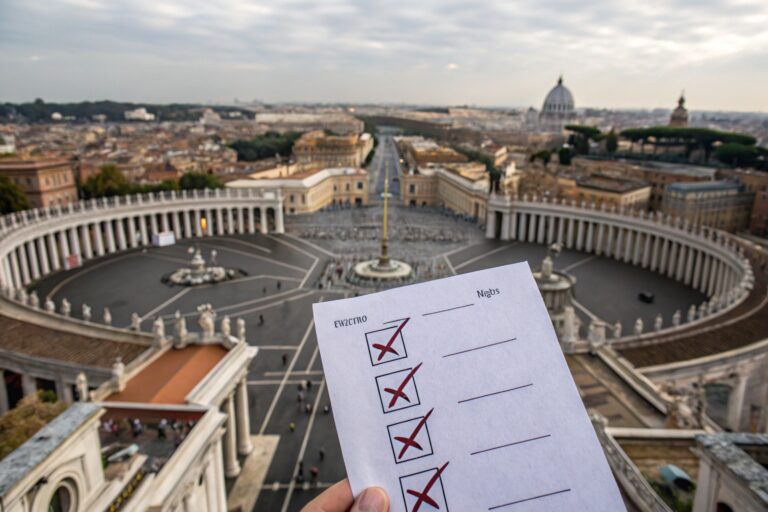
Pilgrimages to Rome for the Jubilee 2025
The 2025 Jubilee in Rome is a unique opportunity for believers worldwide to experience a unique spiritual pilgrimage. From visiting the four major basilicas to paths dedicated to the holy martyrs, pilgrims are invited to renew their faith and discover the religious treasures of the Eternal City. Each journey, imbued with history and tradition, allows for the receipt of indulgences and participation in unforgettable spiritual events.
In this article, we will explore the different possible pilgrimages for the 2025 Jubilee, detailing the main religious itineraries and holy sites to visit.
- 1. Pilgrimage to the Four Major Basilicas of Rome
- St. Peter’s Basilica (Basilica di San Pietro)
- Basilica di San Giovanni in Laterano
- Basilica di San Paolo Fuori le Mura
- Basilica di Santa Maria Maggiore
- 2. Pilgrimage of the Seven Churches of Rome: a traditional pilgrimage
- 3. Pilgrimage of the Way of the Holy Martyrs
- The Catacombs of Rome
- The Colosseum
- 4. Pilgrimage to the Shrine of Divine Love
- 5. Pilgrimage of the Way of Saint Francis of Assisi
- 6. Contemporary Itineraries for the 2025 Jubilee Pilgrims
To get around Rome during pilgrimages, Google Maps is a valuable ally. But why not go even further? Discover our interactive tourist map of Rome, designed to accompany you at all times. It will allow you to quickly identify the must-see sites around you and access detailed information on each location: its history, anecdotes, and our best tips to make the most of it.
1. Pilgrimage to the Four Major Basilicas of Rome
At the heart of any pilgrimage to Rome, the four major basilicas play a crucial role. These churches are the holiest places in Christendom and the most important to visit during a pilgrimage for the Jubilee.
St. Peter’s Basilica (Basilica di San Pietro)
The St. Peter’s Basilica, located in the Vatican, is the epicenter of the Jubilee. This church, the largest in the world, is considered the spiritual residence of the Pope and a central pilgrimage site for Catholics. During the Jubilee, numerous ceremonies are held here, including papal masses, confessions, and processions.
One of the most important traditions is passing through the Holy Door of St. Peter’s Basilica, a special door opened only during Jubilee years. Passing through this door symbolizes the entrance into a new life of faith and grace for believers.
Basilica di San Giovanni in Laterano
The Basilica di San Giovanni in Laterano is the cathedral of the Bishop of Rome, the Pope, and is often called the “mother of all churches”. It is one of the essential stops on pilgrimages during the Jubilee. One of the main traditions there is also to pass through the Holy Door, which allows the faithful to receive an indulgence.
In addition to the Holy Door, pilgrims can visit the main altar, where only the Pope and his representatives can celebrate Mass, as well as the Holy Stairs, or Scala Santa, believed to have been climbed by Jesus during his trial in Jerusalem.
Basilica di San Paolo Fuori le Mura
Located outside the walls of the ancient city of Rome, the Basilica di San Paolo Fuori le Mura is another major holy site to visit during the Jubilee. It is there that the body of Saint Paul, one of the most influential apostles of the Christian Church, rests. Here too, the Holy Door is opened to allow pilgrims to follow a spiritual path towards the renewal of their faith.
Pilgrims can pray in front of the tomb of Saint Paul, admire the magnificent mosaics and the portraits of all the Popes since Saint Peter, and participate in masses and prayers specific to the Jubilee.
Basilica di Santa Maria Maggiore
St. Mary Major Basilica is the largest church dedicated to the Virgin Mary in Rome. It is renowned for its beautiful mosaics and architecture. During the Jubilee, the Holy Door is also opened, allowing pilgrims to immerse themselves in the religious traditions of the Jubilee and receive spiritual graces.
In addition to the Holy Door, pilgrims can pray before the marble manger dating back to the 13th century, and before the venerated icon of the Salus Populi Romani, a Marian image believed to protect the Roman people.
2. Pilgrimage of the Seven Churches of Rome: a traditional pilgrimage
In addition to the four major basilicas, another traditional pilgrimage during the Jubilee is the Pilgrimage of the Seven Churches. This pilgrimage dates back to Saint Philip Neri in the 16th century and involves visiting seven important churches in Rome, each with a particular significance for the faithful.
The seven churches of the pilgrimage are:
- St. Peter’s Basilica in Vatican City
- St. Paul’s Outside the Walls Basilica
- St. John Lateran Basilica
- St. Mary Major Basilica
- St. Lawrence Outside the Walls Basilica
- Basilica of the Holy Cross of Jerusalem
- San Sebastiano fuori le mura (St. Sebastian’s Basilica)
This over 20 km journey is a spiritual undertaking where pilgrims move from church to church to pray, meditate, and participate in religious ceremonies. This pilgrimage can be done in one day or over several days, and it is a profound way to experience the spiritual essence of Rome.
3. Pilgrimage of the Way of the Holy Martyrs
Rome is known for being the resting place of numerous Christian saints and martyrs. For the Jubilee 2025, pilgrims have the opportunity to follow the footsteps of these saints through various pilgrimage sites dedicated to their memory. Here are some places to visit to honor Christian martyrs:
The Catacombs of Rome
The Catacombs of Rome are underground cemeteries where numerous early Christians, including martyrs, were buried. The most famous are the Catacombs of Saint Callixtus, the Catacombs of Saint Sebastian, and the Catacombs of Priscilla. Pilgrims can visit these sites to pray and reflect on the sacrifice of the early Christians.
The Colosseum
Although the Colosseum is generally known as a historical and tourist site, it also holds great spiritual significance for Catholics. It is here that many Christians were martyred during the persecutions of the Roman Empire. During the Jubilee, special celebrations are often held at the Colosseum, including the Stations of the Cross on Good Friday, presided over by the Pope.
4. Pilgrimage to the Shrine of Divine Love
Another popular pilgrimage during the Jubilee is to the Shrine of Divine Love (Santuario della Madonna del Divino Amore), located just outside the city of Rome. This shrine, dedicated to the Virgin Mary, is an important place of Marian devotion.
The pilgrimage to this shrine often takes place on foot at night, with groups of pilgrims departing from Rome in prayer. This shrine is particularly known for the miracles attributed to the Virgin and for the numerous graces obtained by pilgrims who come here. Special masses and prayers will be held there during the Jubilee.
5. Pilgrimage of the Way of Saint Francis of Assisi
For those who wish to extend their pilgrimage beyond Rome, an excellent option is to follow the way of Saint Francis of Assisi, one of the most venerated saints in Italy. This pilgrimage follows the footsteps of Saint Francis through magnificent landscapes, medieval towns, and spiritual sanctuaries.
The journey often begins in Assisi, the birthplace of Saint Francis, where pilgrims can visit the Basilica of Saint Francis, the saint’s resting place. The pilgrimage then continues to La Verna, where Saint Francis received the stigmata, and then to Greccio, where he created the first living nativity scene. This pilgrimage is a unique spiritual experience that connects nature, simplicity, and faith.
6. Contemporary Itineraries for the 2025 Jubilee Pilgrims
In addition to traditional pilgrimages, many contemporary itineraries are offered to pilgrims wishing to participate in the Jubilee. Thanks to technological innovations, such as mobile applications, interactive maps, and digital guides, pilgrims can organize their journey to Rome more easily than ever before.
Special transportation services will be put in place to facilitate access to the various holy sites, and accommodations dedicated to pilgrims will be offered throughout the city of Rome.
The 2025 Jubilee in Rome is a unique spiritual opportunity for the faithful worldwide to renew their faith, obtain indulgences, and discover the religious richness of the Eternal City. Whether visiting the four major basilicas, following the pilgrimage of the seven churches, or honoring the Christian martyrs, each itinerary offers a profound and unforgettable faith experience.
A question about the Jubilee? Browse our article on the most frequently asked questions about the 2025 Jubilee in Rome and find your answers there. Also discover our complete file on the 2025 Jubilee.



